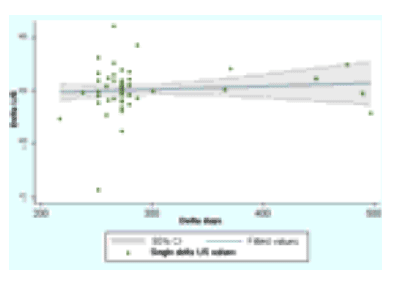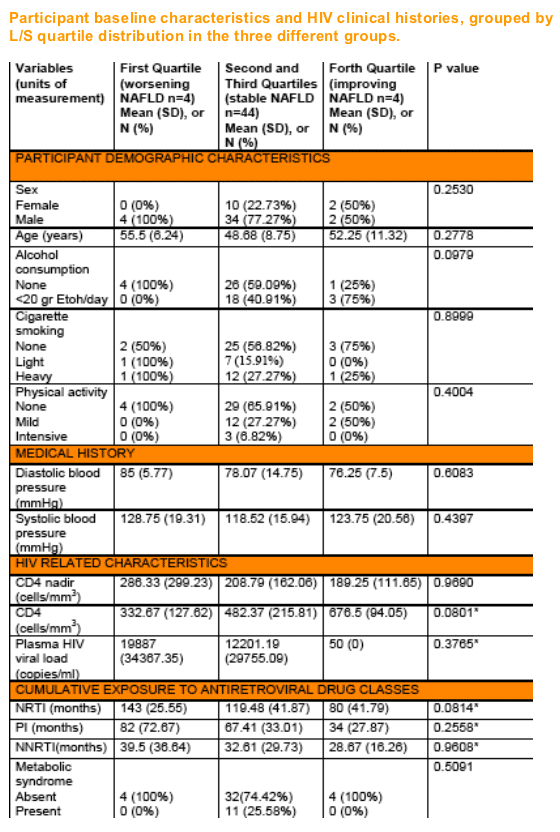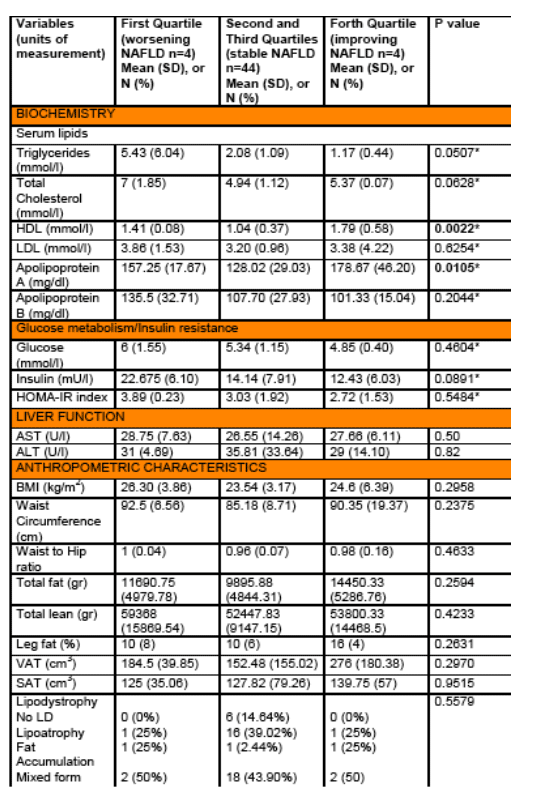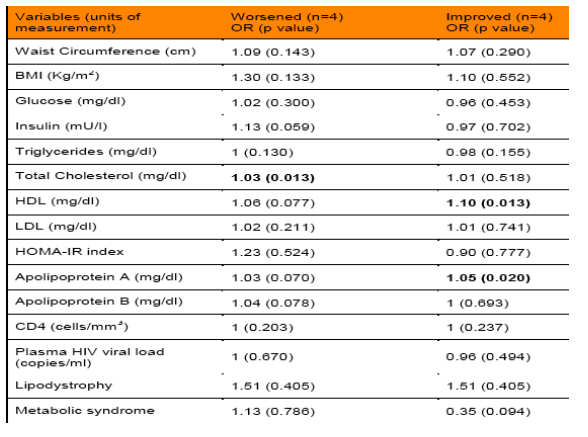 |
 |
 |
| |
EVOLUTION OF NON-ALCOHOLIC FATTY LIVER DISEASE (NAFLD) IN HIV-INFECTED PATIENTS:
INCIDENCE, CHARACTERISTICS AND PREDICTORS
|
| |
| |
Reported by Jules Levin
15th CROI, Feb 3-6, 2008, Boston
Giovanni Guaraldi1, Nicola Squillace1, Chiara Stentarelli1, Gabriella Orlando1, Roberto D'Amico1, Guido Ligabue1, Federica Fiocchi1, Stefano Zona1, Roberto Esposito1 and Frank Palella2
1 University of Modena and Reggio Emilia, Via del Pozzo 71, 41100 Modena, Italy, 2 Northwestern University, Feinberg School of Medicine, Chicago, USA
"In a series of 225 HIV-infected patients we previously demonstrated that exposure to NRTI's comprised an independent risk for the development of NAFLD, with an 11% increase in risk for each year of use (6). This observation corroborates our current findings in which cumulative NRTI exposure was lower among those who experienced NAFLD improvement than among those who with NAFLD worsening.
Metabolic abnormalities identified as risks for NAFLD progression and associated with NAFLD improvement are similar in HIV-infected people and in the general population. Properly designed studies are needed to further assess the role of NRTI use in NAFLD evolution."
Abstract
Non-alcoholic Fatty Liver Disease (NAFLD) occurs among persons without chronic viral hepatitis or significant alcohol (Etoh) consumption. It presents often in the context of cardiovascular risk factors.
Objectives
To assess the incidence and predictors of (NAFLD) in HIV-infected HAART-experienced patients.
Methods This was a 48 week prospective observational study. NAFLD was defined using a liver/spleen (L/S) attenuation value <1.1 by CT in persons without serum HBsAg, HCV Ab, or a significant h/o Etoh consumption. Incidence was defined as the proportion of subjects meeting diagnostic criteria at follow up. Compared to baseline L/S values, quartiles were used to classify people whose liver steatosis (LS) improved (4th quartile) or worsened (1st quartile) during follow up. We used student t-tests and univariate logistic regression models (ULRM) to identify LS risks and predictors of improvement or worsening.
Results
52(*) pts enrolled; 40 male. Baseline (BL) mean age =49 yrs; BMI =23.76±3.45. 27.8% were CDC group C. Mean duration of ARV exposure (in months) was: NRTI,117 ± 41; NNRTI, 33 ± 29; PI, 65 ± 36 months. 88% of persons had lipodystrophy, and 25% had metabolic syndrome. NAFLD was present in 26 patients (prevalence of 45.61%). At f/u NAFLD was diagnosed in 25 patients (incidence of 43.86%). One year incidence of L/S improvement was 4/52 (7.6%).
ULRM revealed that improvement in LS was associated with: higher baseline serum HDL (68.67±22.3 in those who improved vs 41.47±14.29 in those who did not, p<0.001), higher baseline ApoA (178.67±46.2 vs 130.51±29.29, p=0.01), less cumulative NRTI exposure (80±41.7 vs 121.5±41.06, p=0.05), greater baseline leg fat mass (3501±1338 vs 2037±1268, p=0.05).
Worsening of LS was associated with: higher baseline serum triglyceride (TG, 426.25±529.7 vs 176.98±95.2, p<0.001); higher baseline total cholesterol
(270.25±71.28 vs 191.74 ± 40.01, p=0.04); higher baseline ApoB (135.5±32.71 vs 107.28±27.22, p=0.05); higher baseline serum insulin (22.68±6.10 vs 14.03±7.76, p=0.03); reduction in serum HDL (-9.5±9.04 vs -0.12±8.59, p=0.04)
Conclusion: NAFLD is a highly prevalent in HIV-infected persons. Its
development is more likely in the presence of traditional metabolic cardiovascular risks and with greater NRTI exposure.
(from Jules: except that these 'traditional metabolic risks' can be more prominent in hiv+ individuals, who in turn are at greater risk for NASH. So its likely that NASH would be more prevalent among HIV+ individuals with more of these risk factors).
INTRODUCTION
Non-alcoholic Fatty Liver Disease (NAFLD) is a clinico-pathological syndrome that includes a range of disorders associated with fat accumulation in the liver and occurs in the absence of evidence of chronic infection with viral hepatitis or a patient history of significant alcohol consumption (1). Its histological features include macrovesicular steatosis, non-alcoholic steatohepatitis (NASH), fibrosis and cirrhosis (1). The natural history of nonalcoholic fatty liver disease is not well-defined, but it appears to be determined by the severity of histologic damage present. Persons whose liver histology demonstrates simple steatosis may have a benign clinical course, while those with NASH may progress to endstage
liver disease or develop hepatocellular carcinoma (1, 2).
OBJECTIVES
The aim of our study was to assess the incidence and predictors of (NAFLD) in HIV-infected HAART-experienced patients by means of changes in liver to spleen ratios in patients undergoing consecutive abdominal CT scans.
METHODS
This was a prospective observational study that included all consecutive HIV-infected patients seen at the metabolic clinic between January 2006 and June 2007.
Inclusion criteria were: serologically documented HIV-1 infection, age >18 years, at least 2 years of highly active antiretroviral therapy (HAART) exposure and, among persons with hyperlipidemia or hyperglycaemia, receipt of stable lipid-lowering and diabetic medication for at least 6 months.
All participants underwent at least two abdominal CT scan to assess L/S ratio and had a minimum follow-up time of 6 months.
Exclusion criteria were: serological evidence of chronic hepatitis B or C infection documented with HBsAg and HCV Ab, autoimmune hepatitis, hypoglycaemic drug usage, diagnosis of any inborn error of metabolism, evidence of illicit drug use, or alcohol consumption > 20 g of ethanol per day. The outcome variable was NAFLD expressed as a ratio of mean liver/spleen (L/S) attenuation values at CT.
Hepatic and splenic attenuation values were measured on non-contrast CT scans by using circular region of interest (ROI) cursors in the liver and in the spleen. In the liver, ROIs were located in each of the right anterior, right posterior, left medial, and left lateral segments. The L/S ratio was calculated as follows:L/S ratio= average attenuation value of liver (4 points) / attenuation value of spleen.
NAFLD was defined by a liver to spleen ratio < 1.1 (3).
The primary end-point of interest was the change in L/S during the follow-up period. According to this "delta" value, participants were stratified into three different groups according to quartile distribution
RESULTS
Of 52 eligible patients, there were 40 (76.92%) men and 12 (23.08%) women.
Mean age was 49 years (range 35-70 years). Mean follow-up time was 306.08 days (range from 217 to 517 days). Cumulative follow-up observation was 46.96 years.
At baseline liver/spleen ratio of <1.1 was diagnosed in 26 patients, and at follow-up was seen in 25 patients.
In the overall population mean change in the L/S ratio was 0.007±0.21.
The figure depicts the trend of delta L/S during the follow-up period

AUTHOR DISCUSSION
The changes we observed in liver/spleen ratio assumed a normal distribution and since the mean value of change was zero, we considered that the pattern of could have been an expression of random variability around a mean value. However, when we evaluated responses in a quartile distribution, we were able to demonstrate that significant metabolic differences existed between persons who fell in the first (worsening L/S ratio) and the fourth (improving L/S ratio) quartile when compared to the rest of the population.
NAFLD incidence over one year of follow-up,11.53%, was similar to the rate reported by Hamaguchi et al. using ultrasound examination (4). Conversely, the cumulative incidence of fatty liver we observed is nearly ten time the rate seen in the Dionysos study, which was conducted in the same geographic region as our cohort (5). We therefore surmise that HIV-infected patients with NAFLD may possess unique characteristics and/or risk factors predisposing them toward the development of NAFLD in comparison to HIV-seronegative persons with NAFLD. In a series of 225 HIV-infected patients we previously demonstrated that exposure to NRTI's comprised an independent risk for the development of NAFLD, with an 11% increase in risk for each year of use (6). This observation corroborates our current findings in which cumulative NRTI exposure was lower among those who experienced NAFLD improvement than among those who with NAFLD worsening.
Metabolic abnormalities identified as risks for NAFLD progression and associated with NAFLD improvement are similar in HIV-infected people and in the general population. Properly designed studies are needed to further assess the role of NRTI use in NAFLD evolution.


Six patients newly met the NAFLD definition over the follow-up period, giving an incidence of NAFLD of 10.73/100PY. Seven patients who at baseline met NAFLD criteria subsequently did not during follow-up, giving a NAFLD improvement rate of 17.39/PY.
Improvement in L/S was associated with: higher baseline serum HDL (68.67±22.3 for those who improved vs 41.47±14.29 for those who did not, p<0.001), higher baseline ApoA (178.67±46.2 vs 130.51±29.29, p=0.01), less cumulative NRTI exposure in months (80±41.7 vs 121.5±41.06, p=0.05), greater baseline leg fat mass (3501±1338 vs 2037±1268, p=0.05)
A multivariable logistic regression model was performed to compare patient features of persons in the first quartile in comparison to the remaining population. Worsening of L/S was associated with: higher baseline serum triglyceride (TG, 426.25±529.7 vs 176.98±95.2, p<0.001); higher baseline total cholesterol (270.25±71.28 vs 191.74 ± 40.01, p=0.04); higher baseline ApoB (135.5±32.71 vs 107.28±27.22, p=0.05); higher baseline serum insulin (22.68±6.10 vs 14.03±7.76, p=0.03); reduction in serum HDL (- 9.5±9.04 vs -0.12±8.59, p=0.04).
Predictors of L/S change by baseline variables using
multinomial logistic regression

REFERENCES
1.Angulo P. Nonalcoholic fatty liver disease. N Engl J Med. 2002 Apr 18;346(16):1221-31.
2.Bugianesi E, Leone N, Vanni E, Marchesini G, Brunello F, Carucci P, et al. Expanding the natural history of nonalcoholic steatohepatitis: from cryptogenic cirrhosis to hepatocellular carcinoma. Gastroenterology. 2002 Jul;123(1):134-40.
3.Iwasaki M, Takada Y, Hayashi M, Minamiguchi S, Haga H, Maetani Y, et al. Noninvasive evaluation of graft steatosis in living donor liver transplantation. Transplantation. 2004 Nov 27;78(10):1501-5.
4.Hamaguchi M, Kojima T, Takeda N, Nakagawa T, Taniguchi H, Fujii K, et al. The metabolic syndrome as a predictor of nonalcoholic fatty liver disease. Ann Intern Med. 2005 Nov 15;143(10):722-8.
5.Bedogni G, Miglioli L, Masutti F, Castiglione A, Croce LS, Tiribelli C, et al. Incidence and natural course of fatty liver in the general population: the Dionysos study. Hepatology. 2007 Nov;46(5):1387-91.
6.Squillace N, Guaraldi G, Stentarelli C, Orlando G, D'Amico R, Ligabue G, et al. Non-Alcoholic Fatty Liver Disease (NAFLD) In Hiv Infected Patients: Prevalence, Characteristics And Predictors. 11th European AIDS Conference/EACS - October 24-27, 2007-Madrid, Spain Oral Presentation PS5/5.
|
| |
|
 |
 |
|
|